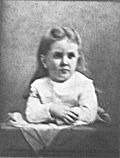William McKinley
William McKinley (January 29, 1843 – September 14, 1901) was an American politician who served as the 25th president of the United States from 1897 until his assassination in 1901. Before becoming president, he was the 39th governor of Ohio from 1892 to 1896.
William McKinley | |||||||||
|---|---|---|---|---|---|---|---|---|---|
 McKinley c. 1900 | |||||||||
| 25th President of the United States | |||||||||
| In office March 4, 1897 – September 14, 1901 | |||||||||
| Vice President |
| ||||||||
| Preceded by | Grover Cleveland | ||||||||
| Succeeded by | Theodore Roosevelt | ||||||||
| 39th Governor of Ohio | |||||||||
| In office January 11, 1892 – January 13, 1896 | |||||||||
| Lieutenant | Andrew L. Harris | ||||||||
| Preceded by | James E. Campbell | ||||||||
| Succeeded by | Asa S. Bushnell | ||||||||
| Member of the U.S. House of Representatives from Ohio | |||||||||
| In office March 4, 1885 – March 3, 1891 | |||||||||
| Preceded by | David R. Paige | ||||||||
| Succeeded by | Joseph D. Taylor | ||||||||
| Constituency |
| ||||||||
| In office March 4, 1877 – May 27, 1884 | |||||||||
| Preceded by | Laurin D. Woodworth | ||||||||
| Succeeded by | Jonathan H. Wallace | ||||||||
| Constituency |
| ||||||||
| Personal details | |||||||||
| Born | William McKinley Jr. January 29, 1843 Niles, Ohio, U.S. | ||||||||
| Died | September 14, 1901 (aged 58) Buffalo, New York, U.S. | ||||||||
| Cause of death | Gangrene due to infection in gunshot wound | ||||||||
| Resting place | McKinley National Memorial, Canton, Ohio | ||||||||
| Political party | Republican | ||||||||
| Spouse(s) | |||||||||
| Children | 2 | ||||||||
| Father | William McKinley Sr. | ||||||||
| Education | |||||||||
| Profession |
| ||||||||
| Signature | |||||||||
| Military service | |||||||||
| Branch/service | United States Army (Union Army) | ||||||||
| Years of service | 1861–1865 | ||||||||
| Rank | Brevet major | ||||||||
| Unit | 23rd Ohio Infantry | ||||||||
| Battles/wars | See list
| ||||||||
| |||||||||
Other offices
| |||||||||
During his presidency, he successfully led the United States in the Spanish–American War, which helped American expansionism by the annexations of Puerto Rico, Guam, the Philippines, and Hawaii.
Presidency
McKinley was inaugurated in the first presidential inauguration to be filmed.[1]
When the USS Maine was sunk, the public wanted war. Congress declared war against Spain. During the Spanish-American War, the Americans conquered Spanish colonies in Latin Ameria and Asia. That started the era of imperialism for the United States.
During his presidency, McKinley also supported higher tariffs, taxes on imports from other countries. During his term, the United States annexed Hawaii, Cuba, the Philippines, and Wake Island.
McKinley was elected to a second term as president in 1900, but it did not last very long.
Death
McKinley was shot by an anarchist, named Leon Czolgosz, on September 6, 1901. McKinley's abdominal gunshot wounds became infected and resulted in gangrene. He died eight days later, and Czolgosz said that the President had committed war crimes in the Philippines and was an enemy of the people. Czolgosz was executed by the electric chair on October 29, 1901. McKinley was the third American president to be assassinated.
After McKinley's death, he was as president by44by Vice President Theodore Roosevelt became president.
Praise
McKinley's biographer H. Wayne Morgan remarks that McKinley died the most beloved president in history.[2]
Kenneth F. Warren emphasizes the national commitment to the pro-business, industrial, and modernizing program that was represented by McKinley.[3]
William McKinley Media
Rutherford B. Hayes was McKinley's mentor during and after the Civil War.
McKinley in 1865, just after the Civil War, photograph by Mathew Brady
Judge magazine cover from September 1890, showing McKinley (left) having helped dispatch Speaker Reed's opponent in early-voting Maine, hurrying off with the victor to McKinley's "jerrymandered" Ohio district
Even after his final run for president in 1884, James G. Blaine was still seen as a possible candidate for the Republican nomination. In this 1890 Puck cartoon, he is startling Reed and McKinley (right) as they make their plans for 1892.
McKinley's close friend and adviser, Mark Hanna
- President McKinley Taking the Oath.webm
McKinley's inauguration, filmed by Thomas Edison
President McKinley's funeral, 1901, part 1
President McKinley's funeral, 1901, part 2
President McKinley's funeral, 1901, part 3
Notes
- ↑ Vice President Hobart died in office. As this was before the adoption of the Twenty-fifth Amendment in 1967, a vacancy in the office of vice president was not filled until the next ensuing election and inauguration.
References
- ↑ "The First US President on Film: William McKinley's Inauguration". School Tube. Archived from the original on December 20, 2024. Retrieved December 20, 2024.
- ↑ Morgan, H. Wayne 2003. William McKinley and his America. Kent, Ohio: The Kent State University Press (revised ed.) ISBN 978-0-87338-765-1
- ↑ Kenneth F. Warren (2008). Encyclopedia of U.S. Campaigns, Elections, and Electoral Behavior. SAGE. p. 211. ISBN 978-1-4129-5489-1.
Other websites
- William McKinley's White House biography Archived 2006-05-04 at the Wayback Machine
| Wikimedia Commons has media related to Lua error in Module:Commons_link at line 62: attempt to index field 'wikibase' (a nil value).. |










